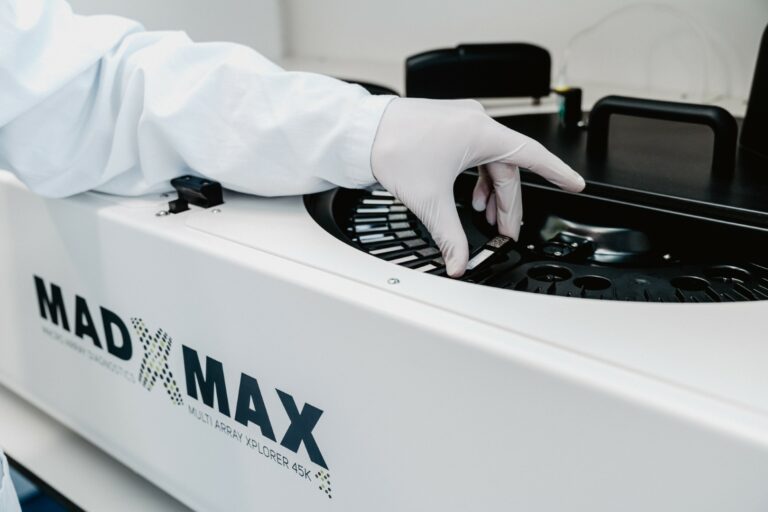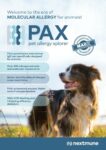PAX® Serum Test
PAX® Serum Test
Molecular allergy – the future of IgE testingPet Allergy Xplorer (PAX®) is the first commercial serological IgE-specific test that uses allergen extracts and molecular components to identify allergen sensitivities.
Molecular allergology is a state-of-the-art approach to the detection of sensitisations, whereby defined single allergen components are used for the determination of specific IgE in place of traditionally-used allergen extracts. The molecular components are purified or recombinant proteins that provide a higher level of standardisation than allergen extracts and enable a more precise identification of IgE sensitisations.

PAX® Screening Environmental
This environmental screening indicates whether any of the tested allergen extracts and components are positive (positive result), or whether they are all are negative (negative result). It does not indicate specific allergens (except for individual Flea result).
PAX® Complete Environmental
This provides individual results for the tested allergen extracts and components. An allergen-specific immunotherapy can then be ordered according to the results. The results come with clear treatment advice.
Key facts about PAX®
- First quantitative multiplex macroarray specifically designed for companion animals
- Over 200 allergens included = lower testing cost per allergen
- Fully automated process = higher level of standardization (same result if tested multiple times)
- With CCD blocking and 2 blocking efficiency detectors
- Only 0.5 ml of serum needed per test
- Expected increase in serological test sensitivity due to a higher concentration of molecular allergens
- Identification of ”primary” sensitizing allergens
- Identification of allergen cross-reactivities
- Selection of relevant allergens for specific immunotherapy

It is preferable to submit serum rather than plasma for the PAX®. A minimum of 0.5 ml is requested to allow for repeated testing in case of need.
There is no relevant influence of icterus, lipemia or hemolysis on the PAX® results.
The PAX® is derived from the ALEX2 used for humans. We first eliminated all extracts and components (i.e., the molecular allergens) that were deemed to be irrelevant for pets (for example, those of kiwi, shrimp, peach, etc…). As the ALEX2 contains few extracts, we then added those that were known to be important for dogs, for example those for the Dermatophagoides farinae house dust mite and the Tyrophagus putrescentiae storage mite.
As there are unique characteristics that make a protein an allergen, we then kept all components from the ALEX2 that would be likely to be targeted by animal IgE.
Finally, we added all components known to be allergens for animals, which were absent from the ALEX2 for humans. After testing more than 1,000 canine sera from Europe, we could see that nearly all extracts and components had yielded positive specific IgE detection in a varying proportion of dogs, thus confirming that the approach for allergen selection was valid. Nextmune will adjust the nature of extracts and components present on the cartridge over time, so that allergens that are non or poorly reactive will be removed. On the other hand, Nextmune scientists will be working to characterize the “allergome” of dogs, cats and horses, so that important new components are regularly added to the cartridges.
Each animal serum tested is diluted in a buffer that contains a proprietary mix of proteins that contain different types of CCDs. The PAX® is also the first veterinary serological test that has incorporated CCD detectors on each cartridge to verify the efficiency of the CCD blocking. In case one of these detectors yields elevated levels of anti-CCD IgE after the initial blocking, the serum is retested a second time after incubation with a higher amount of a different CCD blocker. This second incubation results in a marked decrease in CCD-specific IgE and a noticeable reduction in the number of pollen and plant food IgE positivities.
0,5 ml of serum per test.
Results are available 2 days after arriving at our laboratory.
For the canine test, the PAX® uses the anti-dog IgE monoclonal 5.91, which was produced in the 1990’s by Prof. Bruce Hammerberg at the NC State University College of Veterinary Medicine. This antibody recognizes an epitope in the Ce2 segment of the Fc-fragment of canine IgE. The epitope is distinct from the IgE regions that bind to the high- and low-affinity IgE receptors, thus ensuring that there is no interference from the soluble IgE receptors that are naturally present in allergic dogs. Of importance is that the sequence of the epitope recognized on dog IgE is completely different from that present on canine IgM, IgA and the four different IgG subclasses (IgG1 to IgG4). In fact, we verified, using both standard ELISA and the PAX® that the 5.91 antibody does not bind to canine IgG.
The reports contain four distinct sections:
- A graphic color-coded summary of the positivities, and,
- A text summary of the positivities, and,
- An expanded interpretation of the nature of the positive extracts and components, an information of the expected seasonality of the pollen and mold extracts, details on the importance of the component for allergic humans or animals, and their proven and expected cross-reactivities, and,
- One or more immunotherapy recommendation(s).
The precision was determined in two different conditions:
For the cartridge lot-to-lot variation, two different lots were compared using 54 allergen/sample combinations covering 44 allergens. For the specific IgE values lower than 400 ng/mL, the intra-assay coefficient of variation was 3.0% and the inter-assay coefficient was 7.1%. For the values above 400 ng/mL, these CV% were 2.0 and 5.2%, respectively.
For the determination of the repeatability, three canine serum samples were tested in duplicates in five different runs. As above, for the lower IgE values, the intra- and inter-assay CV% were 6.2 and 8.2%, respectively; those for the higher values were 2.7 and 7.0%, respectively.
Bottom-line: The precision of the PAX® is excellent with results being highly reproducible.
Due to the short half-life of IgE in the serum, the timing of blood sampling for IgE serological testing such as the PAX® is important. For seasonal allergies, the optimal sampling time is at least two weeks after the relevant pollen season started and/or the animal began having a flare of signs. For nonseasonal allergies, the optimal time is at least two weeks after the onset of a flare.
In case of negative PAX® results, re-testing toward the end of the suspected offending pollen season might be warranted (i.e., for tree pollens: toward Spring’s end, for grass and weeds, toward summer’s end; regional variations in such timing occur).
